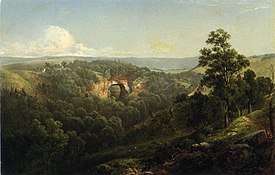John Mathews (Augusta County)
| John Mathews | |
|---|---|
| Personal details | |
| Died |
1756 Augusta County, Virginia |
| Spouse(s) | Ann Archer |
| Relations | Mathews family |
| Children | John, Joshua, Richard, Sampson, George, Archer, William, Jane, Anna, Rachel and Elizabeth |
| Occupation | farmer |
| Military service | |
| Allegiance |
|
| Service/branch | Virginia provincial militia |
| Rank | Captain |
| Battles/wars |
French and Indian War • Braddock expedition |
John Mathews (died 1757) was an 18th-century settler of the Shenandoah Valley. He was among the first residents of Augusta County, Virginia, in which he served in a variety of public offices until his death in 1757. He was the progenitor of the Mathews political family from Augusta County.
Life

John Mathews settled in Augusta County, Virginia by 1737,[1] and in 1742 received a 1,600 acre land grant from George II under patent of governor Robert Dinwiddie,[2] near Natural Bridge, in what is now Rockbridge County.[2] He bought an additional 297 acres in a nearby area called Borden's tract, a 100,000 acre tract parceled and sold almost exclusively to immigrants of the Scotch-Irish immigration.[1][3]
He ran a plantation on his property and incurred raiding from local Native American tribes on at least one occasion.[4] He was commissioned captain of a company of infantry in the Augusta County militia in 1742, and served as an ensign in the French and Indian War. He, along with several of his sons, accompanied George Washington under British General Edward Braddock to the French Fort Duquesne in what is modern-day downtown Pittsburgh, for Braddock's Expedition.[5]
In 1746, in the first election in county history, he was elected to the vestry of the Anglican Church for the Augusta Parish. As an ecclesiastic officer his duties included processioning lands and tending to the poor, among other local needs. In 1751 he was elected a justice of the Magistrate's Court for Augusta County, and as such he issued warrants and reviewed arrests. At this time he also served as a surveyor and oversaw road construction in the county. In the year of his death, 1757, he had become a warden for the county.[4]
Family
John Mathews married Ann Archer, a fellow Scotch-Irish immigrant settler. They had eleven children: John, Joshua, Richard, Sampson, George, Archer, William, Jane, Anna, Rachel and Elizabeth. Several children and later descendants played a role in the public life of Virginia and other southern states.[1]
Notable descendants of John Mathews include Governor of Georgia George Mathews, Revolutionary War colonel Sampson Mathews, Chief Justice of the Louisiana Supreme Court George Mathews Jr., Governor of West Virginia Henry M. Mathews, Virginia Delegates Archer Mathews, John Mathews, James W. Mathews, Sampson Mathews Jr., and Mason Mathews; US Consul George G. Mathews, Bishop James Hervey Otey, and Air Service commander Mason M. Patrick.
See also
References
- 1 2 3 Waddell, Joseph A (1902) "Annals of Augusta County, Virginia, from 1726 to 1871 Waddell's Annals of Augusta County, Virginia, from 1726 to 1871, Retrieved October 20, 2012
- 1 2 Orange County Virginia Deed Book 10, Dorman, pg. 54
- ↑ "...summer of 1717...", Fischer, David Hackett, Albion's Seed: Four British Folkways in America, Oxford University Press, USA (March 14, 1989), pg. 606; "...early immigration was small,...but it began to surge in 1717.", Blethen, H.T. & Wood, C.W., From Ulster to Carolina, North Carolina Division of Archives and History, 2005, pg. 22; "Between 1718 and 1775", Griffin, Patrick, The People with No Name, Princeton University Press, 2001, pg 1; etc.
- 1 2 Chalkley, Lyman (1912) Chronicles of the Scotch-Irish Settlement in Virginia, Extracted from the Original Court Records of Augusta County, 1745–1800 (Washington, D.C.: Daughters of the American Revolution, 1912).
- ↑ Withers, Alexander S. (2009). "Chronicles of Border Warfare." Applewood Books, 2009. https://www.gutenberg.org/files/29244/29244-h/29244-h.htm Retrieved December 29, 2012.